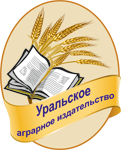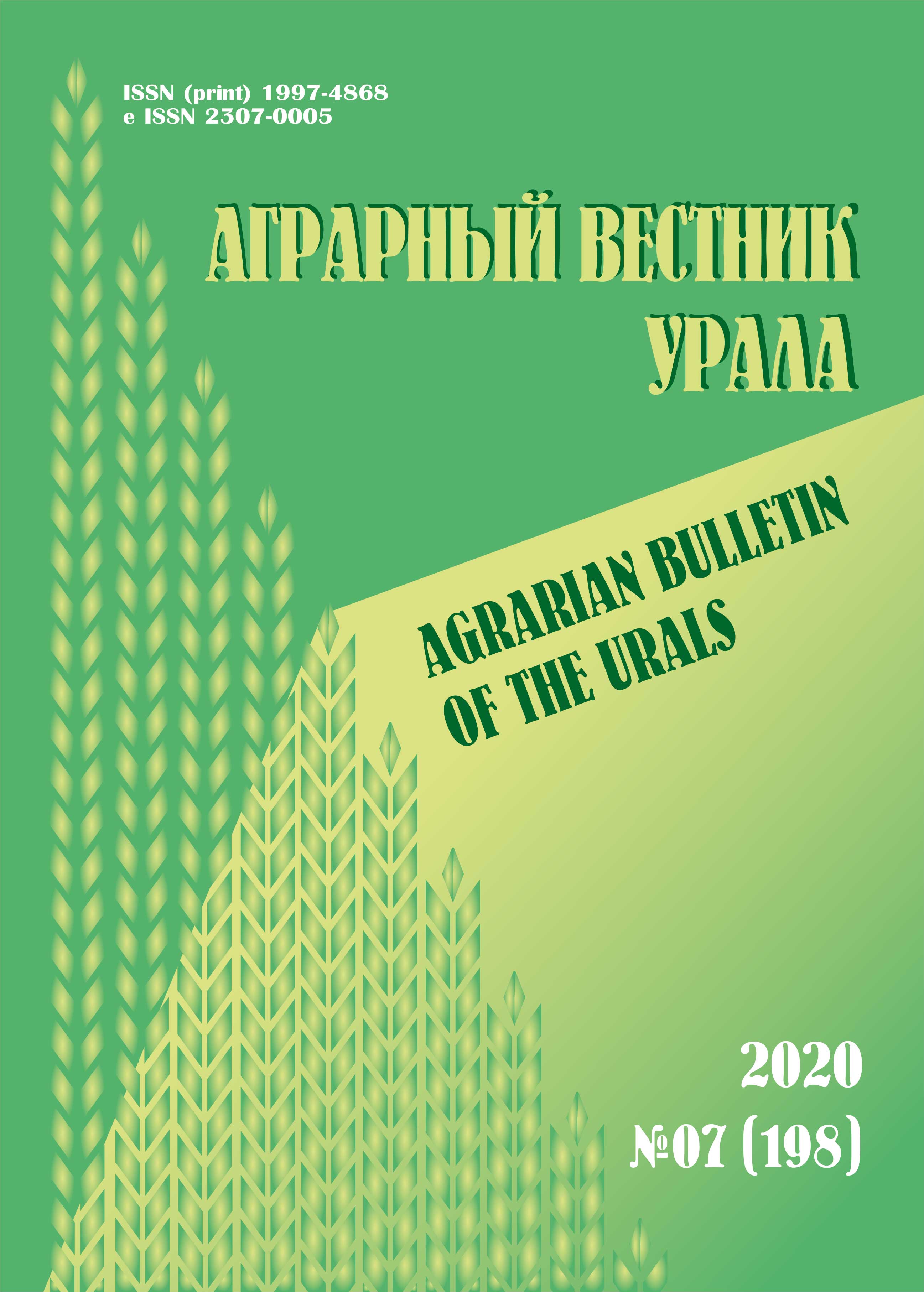Russian Federation
Abstract. The work purpose is to evaluate the adaptability, plasticity and stability of new varieties of winter wheat in competitive variety testing, to identify the best ones for the soil and climatic conditions of the Udmurt Republic. In 2017–2020, seven varieties of winter wheat participated in competitive variety testing. Sowing was carried out in the last five days of August. The seeding rate is 6 million germinating grains. Predecessor was green manure fallow (clover 2 year of use). The adaptability of varieties was determined by the method of A. V. Kilchevsky and L. V. Khotyleva (1985), plasticity according to S. A. Eberhart, W. A. Russell (1966), analysis of variance and coefficient of variation according to B. A. Dospekhov (1985). On average for 2017–2018, 2020, the varieties Italmas and 2.05/3 had the highest yield (4.69–4.88 t/ha) and overall adaptive capacity (4.10 and 1.98 t/ha). The varieties Lyubava and DaUR were more stable (σ2CACi 25,72 and 26,08). Varieties Italmas, A-683, 2.05/3 and Lyubava were characterized by high plasticity and responsiveness to favorable conditions (bi > 1). The varieties Italmas, DaUR and 2.05/3 had breeding value (breeding value of the genotype was 26.84–27.38). Varieties Italmas, 2.05/3 and A-683 were the most winter-hardy. Variety DaUR showed greater resistance to damping-off under the conditions of 2019, providing overwintering by 24 % and exceeding other varieties by 9–19 % (the least significant difference (95 %) of private differences is 7 %). Standard Moskovskaya 39 showed high resistance to lodging under provocative conditions, varieties Italmas and 2.05/3 were moderately resistant. Varieties Moskovskaya 39 and 3.05/21 formed the highest gluten content in grain (30.7 %), but its quality is satisfactory (Group II). Good gluten of the I quality group was obtained from varieties DaUR and 2.05/3. High-glassy grain in all years of study was noted in the Moskovskaya 39 standard.
general adaptive capacity and plasticity of yield, resistance to snow mold
1. Issledovanie peredovoy rossiyskoy i zarubezhnoy praktiki v oblasti povysheniya proizvoditel'nosti truda v sfere proizvodstva zernovyh kul'tur. Dekabr' 2019 [Elektronnyy resurs]. URL: https://proizvoditel'nost'.rf/documents/151/%D0%98%D1%81%D1%81%D0%BB%D0%B5%D0%B4%D0%BE%D0%B2%D0%B0%D0%BD%D0%B8%D0%B5_%D0%B7%D0%B5%D1%80%D0%BD%D0%BE%D0%B2%D1%8B%D0%B5_%D0%BA%D1%83%D0%BB%D1%8C%D1%82%D1%83%D1%80%D1%8B_%D0%B8%D0%BD%D1%82%D0%B5%D1%80%D0%B0%D0%BA%D1%82%D0%B8%D0%B2_%D0%A0_i7Z3NIN.PDF (data obrascheniya: 04.04.2022).
2. Petrov L. K. Ocenka urozhaynosti, ekologicheskoy stabil'nosti i plastichnosti sortov ozimoy pshenicy v usloviyah Nizhegorodskoy oblasti // Rossiyskaya sel'skohozyaystvennaya nauka. 2020. № 3.S. 6-9. DOI:https://doi.org/10.31857/S2500262720030023. EDN: https://elibrary.ru/ELDXQF
3. Dolgosrochnaya strategiya razvitiya zernovogo kompleksa Rossiyskoy Federacii do 2035 goda [Elektronnyy resurs]. URL: https://docs.cntd.ru/document/560974985#6560IO (data obrascheniya: 04.04.2022).
4. Evdokimov M. G., Belan I. A., Yusov V. S., Kovtunenko A. N., Roseeva L. P. Adaptivnyy potencial sortov pshenicy (ozimoy, yarovoy myagkoy i yarovoy tverdoy) selekcii Omskogo agrarnogo nauchnogo centra // Dostizheniya nauki i tehniki APK. 2020. T. 34. № 10. S. 9-15. DOI: https://doi.org/10.24411/0235-2451-2020-11001; EDN: https://elibrary.ru/HCIBOQ
5. Yan-Lei D., Yue X., Ting C., Anten N.P.R., Weiner J., Xinmao L., Turner N. C., Yi-Min Z., Feng-Min L. Yield components, reproductive allometry and the tradeoff between grain yield and yield stability in dryland spring wheat [e-resource] // Field Crops Research. 2020. Vol. 257. Article number 107930. DOI:https://doi.org/10.1016/j.fcr.2020.107930. URL: https://www.sciencedirect.com/science/article/pii/S0378429020312144) (date of reference: 15.04.2022).
6. Owusu G. A., Nyadanu D., Owusu-Mensah P., Adu Amoah R., Amissah S., Danso F. C. Determining the effect of genotype × environment interactions on grain yield and stability of hybrid maize cultivars under multiple environments in Ghana [e-resource] // Ecological Genetics and Genomics. 2018. Vol. 9. Pp. 7-15. DOI:https://doi.org/10.1016/j.egg.2018.07.002. URL: https://www.sciencedirect.com/science/article/pii/S2405985418300028 (date of reference: 15.04.2022). EDN: https://elibrary.ru/YIOUTZ
7. Ahakpaz F., Abdi H., Neyestani E., Hesami A., Mohammadi B., Mahmoudi K. N., Abedi-Asl G., Noshabadi M. R. J., Ahakpaz F., Alipour H. Genotype-by-environment interaction analysis for grain yield of barley genotypes under dryland conditions and the role of monthly rainfall [e-resource] // Agricultural Water Management. 2021. Vol. 245. Article number 106665. DOI:https://doi.org/10.1016/j.agwat.2020.106665. URL: https://www.sciencedirect.com/science/article/pii/S0378377420322095 (date of reference: 15.04.2022). EDN: https://elibrary.ru/WPXICI
8. Torop A. A., Chaykin V. V., Torop E. A., Kuz'menko S. A. Prakticheskoe ispol'zovanie v selekcii ozimoy rzhi sposobov, pozvolyayuschih sochetat' v sorte vysokuyu urozhaynost' i adaptivnost' k usloviyam sredy // Dostizheniya nauki i tehniki APK. 2020. T. 34. № 3. S. 33-35. DOI: https://doi.org/10.24411/0235-2451-2020-10306; EDN: https://elibrary.ru/MEZKBU
9. Kil'chevskiy A. V., Hotyleva L. V. Ekologicheskaya selekciya rasteniy. Minsk: Tehnalogia, 1997. 372 s. EDN: https://elibrary.ru/FFLTCU
10. Rybas' I. A. Povyshenie adaptivnosti v selekcii zernovyh kul'tur [Elektronnyy resurs] // Sel'skohozyaystvennaya biologiya. 2016. № 5. S. 617-626. URL: https://cyberleninka.ru/article/n/povyshenie-adaptivnosti-v-selektsii-zernovyh-kultur (data obrascheniya: 06.04.2022). DOI: https://doi.org/10.15389/agrobiology.2016.5.617rus; EDN: https://elibrary.ru/WZJQEN
11. Grabovec A. I., Fomenko M. A.. Stabil'nost' urozhaev v shirokom diapazone sred - osnovnoy parametr pri selekcii ozimoy pshenicy // Rossiyskaya sel'skohozyaystvennaya nauka. 2020. № 5. S. 3-7. DOI:https://doi.org/10.31857/S2500262720050014. EDN: https://elibrary.ru/FLUFOW
12. Vasil'ev A. A. Dergileva T. T., Dergilev V. P. Ocenka adaptivnogo potenciala belorusskih sortov kartofelya v usloviyah Chelyabinskoy oblasti // Agrarnyy vestnik Urala. 2021. № 4 (207). S. 17-23. DOI:https://doi.org/10.32417/1997-4868-2021-207-04-17-23. EDN: https://elibrary.ru/KXPZBP
13. Rozhmina T. A., Zhuchenko A. A. ml., Rozhmina N. Yu., Kiseleva T. S., Gerasimova E. G. Novye istochniki selekcionno-znachimyh priznakov l'na, adaptirovannye k usloviyam Central'nogo Nechernozem'ya // Dostizheniya nauki i tehniki APK. 2020. T. 34. № 8. S. 20-55. DOI:https://doi.org/10.24411/0235-2451-2020-10808. EDN: https://elibrary.ru/QCEZCP
14. Kil'chevskiy A. V., Hotyleva L. V. Metod ocenki adaptivnoy sposobnosti i stabil'nosti genotipov, differenciruyuschey sposobnosti sredy Soobschenie 2. Chislovoy primer i obsuzhdenie // Genetika. 1985. T. XXI. № 9. S. 1491-1498. EDN: https://elibrary.ru/BJCOZO
15. Litvinova M. K., Meshkov A. V., Pustovalova S. V. Metodicheskoe posobie dlya vypolneniya uchebnyh zanyatiy i samostoyatel'noy raboty po selekcii ovoschnyh kul'tur po teme «Adaptivnyy podhod k semenovodstvu». Michurinsk: Izdatel'stvo Michurinskogo gosudarstvennogo agrarnogo universiteta, 2005. 19 s.
16. Pakudin V. Z., Lopatina L. M. Ocenka ekologicheskoy plastichnosti i stabil'nosti sortov sel'skohozyaystvennyh kul'tur // Sel'skohozyaystvennaya biologiya. 1984. № 4. S. 109-113.
17. Hangil'din V. V. O principah modelirovaniya sortov intensivnogo tipa // Genetika kolichestvennyh priznakov sel'skohozyaystvennyh rasteniy. Moskva, 1978. S. 111-116.
18. Ozimye zernovye kul'tury v Udmurtskoy Respublike: monografiya / N. G. Tuktarova, A. G. Kuryleva, S. S. Zhirnyh, I. V. Torbina. Izhevsk: OOO PKF «Bukva», 2017. 124 s.
19. Torbina I. V., Fardeeva I. R. Adaptivnost' kollekcionnyh obrazcov ozimoy pshenicy k usloviyam Srednego // Vestnik Kazanskogo GAU. 2021. № 2 (62). S. 43-49. DOI: https://doi.org/10.12737/2073-0462-2021-43-48; EDN: https://elibrary.ru/DUSATX
20. Torbina I. V., Fardeeva I. R. Ozimaya pshenica selekcii Udmurtskogo NIISH UdmFIC UrO RAN v konkursnom sortoispytanii // Izvestiya TSHA. 2020. № 3. S. 5-16. DOI:https://doi.org/10.26897/0021-342X-2020-3-5-16. EDN: https://elibrary.ru/SCPQFS
21. Sheshegova T. K. Sozdanie ishodnogo materiala dlya selekcii ozimoy rzhi na ustoychivost' k vyprevaniyu v Severo-Vostochnoy chasti Nechernozemnoy zony Rossii: avtoref. dis. … kand. s.-h. nauk. Sankt-Peterburg, 1993. 19 s. EDN: https://elibrary.ru/ZLSNTN
22. Kuryleva A. G., Kurylev M. V., Fatyhov I. Sh. Monitoring rasprostraneniya osnovnyh bolezney ozimyh zernovyh kul'tur v Udmurtskoy Respublike // Intellektual'nyy vklad tyurkoyazychnyh uchenyh v sovremennuyu nauku: materialy Mezhdunarodnoy nauchnoy konferencii, posvyaschennoy 30-letiyu Tatarskogo obschestvennogo centra Udmurtii. Izhevsk, 2021. S. 324-327. EDN: https://elibrary.ru/KVOLVX
23. Fitosanitarnyy monitoring naibolee vredonosnyh bolezney ozimoy rzhi v Respublike Tatarstan / M. L. Ponomareva, S. N. Ponomarev, G. S. Mannapova, L. V. Ilalova // Vestnik KrasGAU. 2019. № 9 (150). S. 27-34. EDN: https://elibrary.ru/UMBDMO
24. Potapova G. N., Galimov K. A., Zobnina N. L. Produktivnost' i adaptivnost' sortov ozimoy rzhi na Srednem Urale // Dostizheniya nauki i tehniki APK. 2020. T. 34. № 10. S. 28-33. DOI:https://doi.org/10.24411/0235-2451-2020-11004. EDN: https://elibrary.ru/GGNUZZ
25. Kovalenko S. A., Kadushkina V. P., Biryukova O. V. Steklovidnost' zerna yarovoy tverdoy pshenicy v usloviyah severa Rostovskoy oblasti [Elektronnyy resurs] // Zernobobovye i krupyanye kul'tury. 2021. № 1 (37). URL: https://cyberleninka.ru/article/n/steklovidnost-zerna-yarovoy-tverdoy-pshenitsy-v-usloviyah-severa-rostovskoy-oblasti (data obrascheniya: 25.03.2022).









